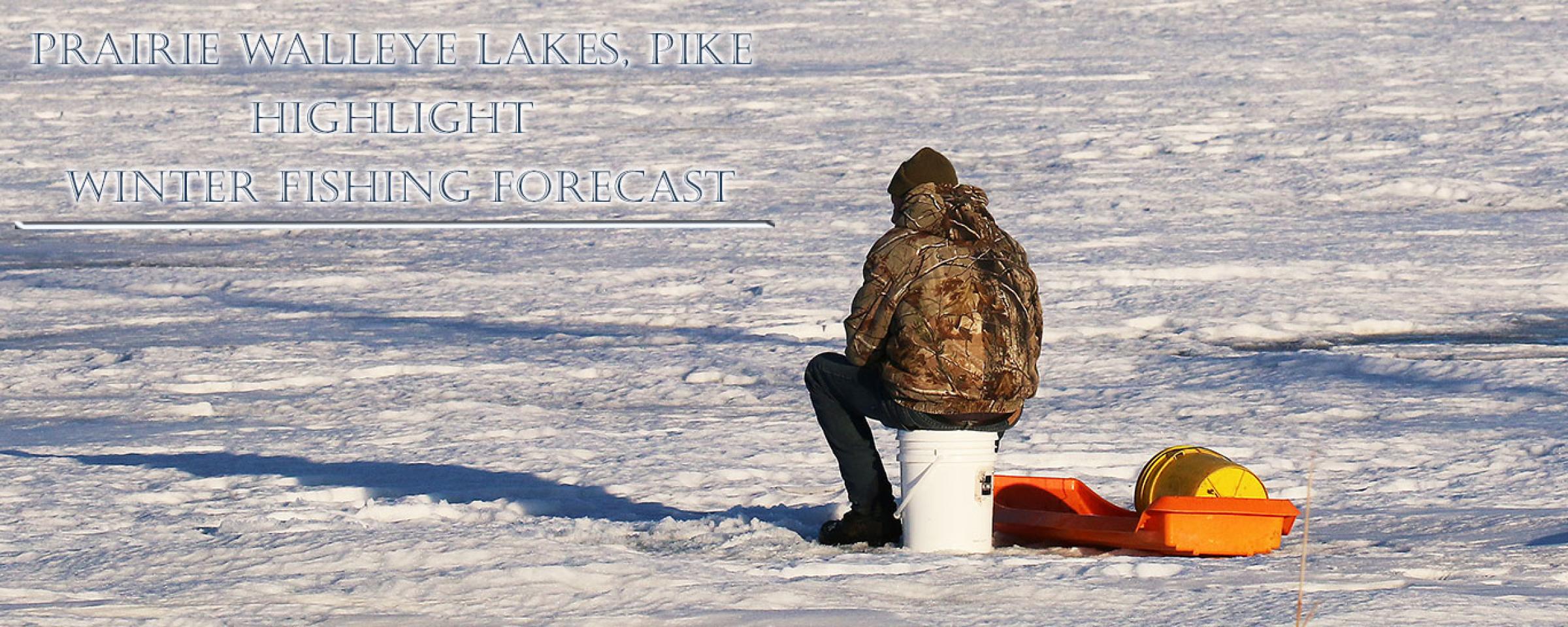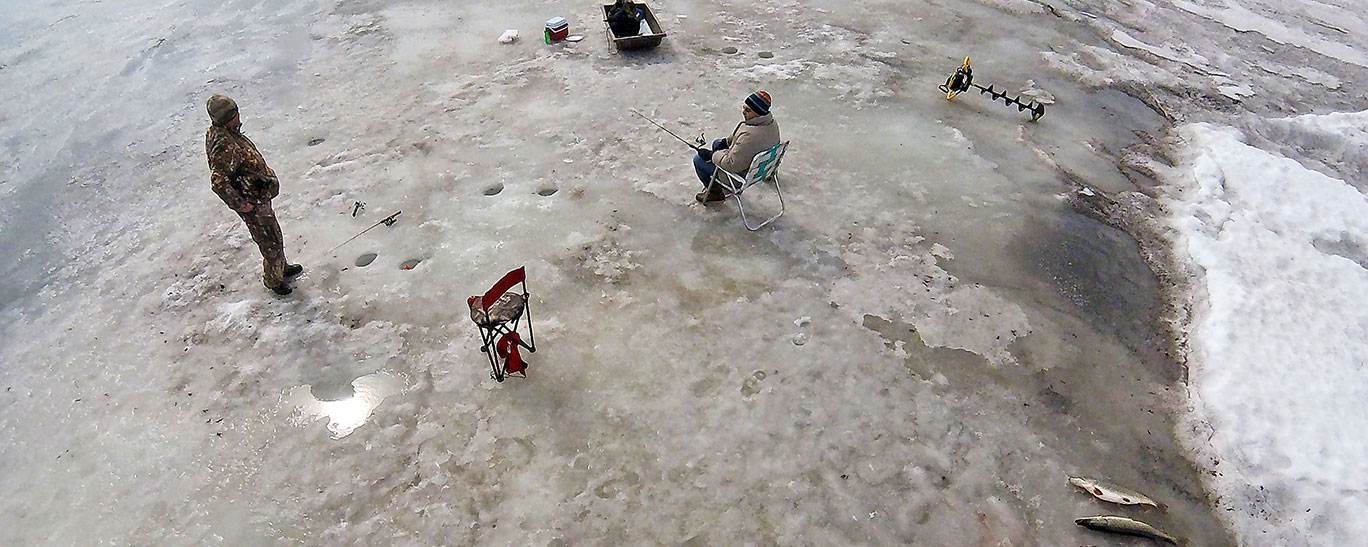
Prairie Walleye Lakes, Pike Highlight Winter Fishing Forecast
There are no guarantees when it comes to ice fishing in North Dakota.
Considering the uncertainties of the weather, and how it influences freeze-up and access, anglers really never know how things are going to play out.
Last year, following a mild November, December bared its teeth in parts of the state with record snowfall and cold temperatures. Access to many waters was difficult or worse.

A nice walleye through the ice for a young angler.
“Ice fishing in North Dakota is really predicated on access and good fishing opportunities,” said Greg Power, North Dakota Game and Fish Department fisheries division chief. “Obviously, the weather is the one variable we don’t have control over.”
In a perfect ice fishing world, Power said, North Dakota’s waters would experience a typical freeze-up beginning around deer season, followed by colder weather in December, with little snow accumulation.
“What we’ve seen is that if you don’t get anglers on good ice, with good access, by the holidays, then they don’t often fish that winter,” Power said. “The lakes and the fish are out there, but it’s just a matter of anglers being able to gain access to where they want to fish.”
Typically, Power said, when access isn’t an issue, ice fishing accounts for about 25 percent of all fishing that occurs annually in North Dakota. In tough winters, where access is limited, this can drop to as low as 5 percent.
While blowing and drifting snow can, at times, make getting on a lake difficult, Power reminds anglers that the agency doesn’t provide access.
“If you see that an access has been plowed or blown out, it’s being done by a local fishing club or local landowners,” he said. “We don’t have the resources to maintain the 1,000-plus access sites around the state.”
The other side of the weather picture, and its likely influence on the ice fishing season and fish populations, is drought that gripped North Dakota in spring and summer.
Scott Gangl, Department fisheries management section leader, said that while many fisheries in North Dakota lost water to drought, not all lakes were affected the same.
“The last five or six years we’ve had increasing water levels and increasing fish populations,” Gangl said. “While our fish populations are still doing well, the concern is that when you lose water, you are losing fish habitat, and that increases the risk for winterkill.”
Even so: “I’m still pretty optimistic,” he added. “This one dry summer is not going to cause 40-50 lakes to winterkill. We’ve been so water-rich for years that many of our lakes are going to be just fine.”
Falling water levels particularly influence yellow perch, which are one of the more popular fish species for winter anglers.
“To have a year where we are actually drying out a bit is probably going to affect things like perch reproduction,” Gangl said. “We are probably not going to see a lot of perch this year because they really thrive on that flooded vegetation.”
Gangl said yellow perch populations in North Dakota tend to boom and bust in direct correlation to the state’s water cycle.
“Right now, coming off a dry spring and summer, we’re kind of on the backside of the boom,” he said.
Understanding that, Gangl and Power both remain optimistic about quality ice fishing opportunities, considering the state’s continued robust pike population and a host of healthy prairie walleye lakes.
“We have to re-channel angler expectations away from perch to pike and walleye, which is not a bad thing because those opportunities are widely available,” Power said. “We have evolved to stocking many of the opportunistic perch lakes with walleye and this winter could prove to be pretty good. There are a scattering of lakes with 14- to 17-inch walleye that experience very little fishing pressure.”
Gangl said many of the former perch waters that have since been stocked with walleye were flush with fathead minnows, providing plenty of prey to the newcomers.
“Many of the waters were full of minnows and the walleye grew like crazy,” Gangl said. “A lot of these new prairie walleye fisheries will be the keystone of North Dakota’s ice fishing season.”

Fishing for Opportunities on Ice
What follows are a number of fisheries around North Dakota that, depending on ease of access and other factors, could provide good ice fishing opportunities for walleye, northern pike and other species. Some of the waters are only accessible in winter, while others see fishing pressure during the open water season. Game and Fish Department district fisheries supervisors and biologists have provided a short look at fish populations in each water to help frame ice fishing expectations. Following continued dry conditions and falling waters levels, some fisheries will be more susceptible to winterkill than others.
South Central Fisheries District
Paul Bailey, district fisheries supervisor, Bismarck
- Crimmins WPA (Burleigh County) – Walleye up to 22 inches in good numbers.
- Goose Lake (Emmons County) – Good number of northern pike, with fish occasionally surpassing 8 pounds.
- Helen Lake (Kidder County) – A consistent northern pike producer for years and remains a good option for fish up to 10 pounds.
- Horsehead Lake (Kidder County) – This large body of water is a great destination for pike up to 10 pounds.
- Long Alkaline Lake (Kidder County) – Abundant pike up to 5 pounds.
- Nagel Lake (McIntosh County) – Healthy walleye population, with fish up to 25 inches. Foot traffic access through WPA.
- Rafferty Lake (Kidder County) – Walleye from 13-18 inches abundant.
- Remmick Lake (Kidder County) – Small walleye abundant, but fish up to 23 inches present.
- Round Lake (Kidder County) – Walleye not extremely abundant, but fish occasionally surpass 25 inches. Fair numbers of pike and yellow perch.
- Woodhouse Lake (Kidder County) – Walleye abundant, with a few fish exceeding 25 inches.
- Baumgartner Lake (Emmons County) – Pike up to 6 pounds abundant.
- Geier Lake (Kidder County) – Walleye up to 22 inches abundant and a lower number of larger perch.
- Lake Geneva (Kidder County) – Walleye up to 21 inches abundant, with a number of perch up to 13 inches.
- Leno Lake (Kidder County) – A good fishery for 2- to 5-pound pike.
- Logan WMA (Logan County) – Walleye up to 22 inches abundant.
- Trautmann Lake (Kidder County) – An excellent population of 14- to 21-inch walleye.
- Wentz WPA (Logan County) – Walleye up to 20 inches common.
Northeast Fisheries District
Randy Hiltner, district fisheries supervisor, Devils Lake
- Sibley Lake (Griggs County) – Shallow lake, with declining water levels. Pike numbers and size are very good, with fish averaging more than 5 pounds.
- Island Lake (Rolette County) – A larger, shallow lake that is susceptible to winterkill in harder winters. Pike numbers are very good, with fish averaging about 25 inches.
- Long Lake (Rolette County) – A large, shallow lake with falling water levels that could winterkill. Netting survey in 2016 sampled lots of pike averaging nearly 5 pounds.
- School Section Lake (Rolette County) – Shallow lake susceptible to winterkill after a hard winter. Good number of various-sized pike up to 30 inches, along with some perch.
- Heaton Slough Complex (Wells County) – Water levels receding the past couple of years. Two different water bodies exist, with some nice perch and pike from 3-10-plus pounds.
- Silver Lake WMA (Wells County) – Low water levels going into winter may lead to winterkill. Fair numbers of 9- to 11-inch perch, with the occasional jumbo. Fast-growing walleye will be 15-17 inches this winter.
Southwest Fisheries District
Jeff Hendrickson, district fisheries supervisor, Dickinson
- Dickinson Reservoir (Stark County) – Abundant walleye up to 6 pounds and a good number of pike up to 11 pounds, with a good number of perch up to 1 pound.
- Heart Butte Reservoir (Grant County) – Mostly small walleye abundant, with some fish up to 7 pounds, and pike up to 7 pounds.
- Indian Creek Dam (Hettinger County) – Walleye abundant, with some up to 10 pounds.
Northwest Fisheries District
Aaron Slominski, fisheries biologist, Williston
- Northgate Dam (Burke County) – Good walleye and bluegill populations.
- Blacktail Dam (Williams County) – Good numbers of pike, perch and bluegill, with a fair number of walleye.
- McGregor Dam (Williams County) – Good number of walleye.
North Central Fisheries District
Jason Lee, district fisheries supervisor, Riverdale
- Coal Lake (McLean County) – Good number of walleye from 12-14 inches.
- Scooby Lake (McLean County) – Good number of walleye from 12-14 inches.
- Clear Lake (Pierce County) – Abundant walleye with many fish from 14-17 inches.
- Hinsz Lake (Sheridan County) – Good number of walleye from 14-16 inches.
- Lake Richard (Sheridan County) – Decent number of 13- to 20-inch walleye. Shallow lake, with a high risk of winterkill in a long winter with lots of snow.
- Makoti Lake (Ward County) – Abundant northern pike from 29-32 inches.
- Long Lake (McLean County) – Good number of 22- to 26-inch northern pike. Shallow lake, with a high risk of winterkill if covered in a lot snow for an extended period.
- Lake Gertie (McLean County) – Good number of pike from 22-29 inches.
Southeast Fisheries District
Brandon Kratz, district fisheries supervisor, Jamestown
- Mosher WPA (Barnes County) – First stocked with walleye in 2014, and contains an excellent population of 15- to 20-inch fish. Exclusively a walleye lake.
- Island Lake (Barnes County) – Contains an excellent population of 15- to 24-inch walleye. Some perch present, but primarily a walleye lake.
- Kee Lake (Barnes County) – Contains a good number of walleye up to 25 inches. Average size around 2 pounds. A few pike and perch present.
- Wahl Lake (Richland County) – Wahl Lake has receded considerably the last several years, with the maximum depth at approximately 8 feet. Contains an excellent population of walleye from small to large. Some perch, crappie and bluegill.
- Flood Lake (LaMoure County) – Contains a healthy population of northern pike, averaging more than 5 pounds. Less water translates into higher fish densities.
- Sunday Lake (Stutsman County) – Contains a good population of northern pike, averaging more than 4 pounds.
- Grass Lake (Sargent County) – Though Grass Lake contains both walleye and northern pike, in recent years the crappie population has taken off, with abundant 10- to 12-inch fish. Water levels have receded considerably.

Free Ice Fishing Weekend
North Dakota’s free ice fishing weekend is December 30-31.
Resident anglers may fish that weekend without a license. All other ice fishing regulations apply.
Those interested in darkhouse spearfishing that weekend must register with the North Dakota Game and Fish Department prior to participating. Registration is available online or through any Game and Fish office. Legal fish are northern pike and nongame species.
